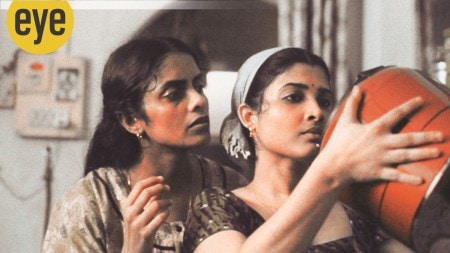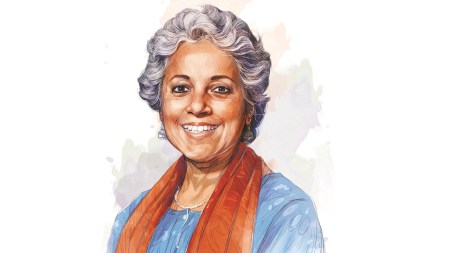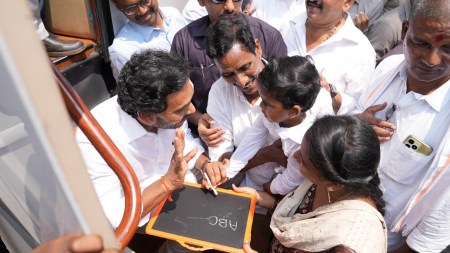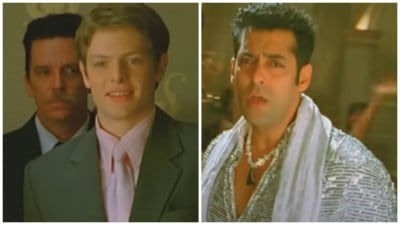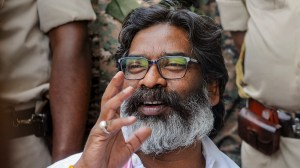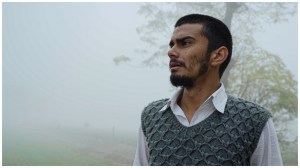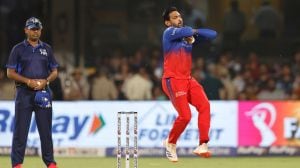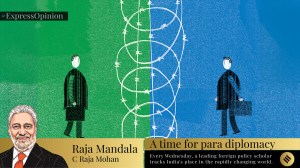- India
- International
Till the end, Tollywood tried to live up to the phenomenon called Soumitra Chatterjee
Soumitra Chatterjee dead: In Mrinal Sen’s Akash Kusum, Soumitra Chatterjee plays an ambitious middle-class executive, who is losing everything he values because of one bad decision. The Hindi remake Manzil starred Amitabh Bachchan, but a back-to-back viewing of both these films will tell you how nuanced Chatterjee’s turn as Ajoy was.
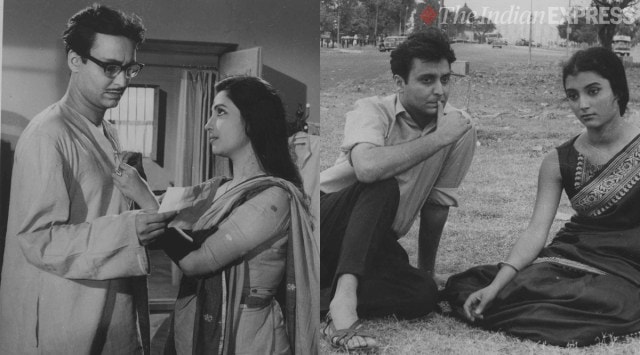 Soumitra Chatterjee passed away on Sunday. He was 85.
Soumitra Chatterjee passed away on Sunday. He was 85. The youth we see in the first twenty minutes of Satyajit Ray’s Apur Sansar (1959), has very few speaking lines. We see him negotiate lanes of a bustling Kolkata, looking out of the window of a tram, taking in the sites of the city, dodging his landlord, all this with eyes of a person who has seen much more than his years. He is battle-weary, yet there is still a flicker of life in those eyes. But things change almost magically in a scene that is now iconic among Bengali youngsters who dare to dream beyond their station. Apurba, a boy from rural Bengal, who has no one left in the world to call his own, tells his best friend about his unwritten autobiography. His eyes light up, his body language changes, his voice quivers with emotions that only dreams can fuel. In those few moments, Satyajit Ray, considered by many to be one of the most important filmmakers of the 20th century, gives the audience a rare gift. We see the birth of a protagonist. At that moment, world cinema is gifted Soumitra Chatterjee.
Apur Sansar, the final act of Ray’s Apu Trilogy, was Chatterjee’s debut film, but if wouldn’t be foolhardy to say that Ray was just waiting to happen to the boy from Krishnanagar, a town about 100 km away from Kolkata. Chatterjee, who had flourished under the tutelage of another Bengali icon, theatre veteran Sisir Bhaduri, had auditioned for the second installment of the trilogy, Aparajito (1956), as a twenty-year-old. “I was in college when Pather Panchali (1955) was released. When Manikda (as Ray is fondly called) was looking for someone to play the lead in Aparajito (1956), a friend of mine, who was assisting him, introduced me to him. He found me to be too grown up and tall for that role,” Chatterjee told The Indian Express in an earlier interview.
Eventually, Ray decided to cast Chatterjee as an older version of the same character in Apur Sansar.
For the Uttam Kumar-marinated Bengali film audience, an unlikely star was born. Soumitra Chatterjee, who has repeatedly confessed that he was very conscious of his looks, didn’t have the self-conscious swagger of Uttam Kumar, the man who he was to play second fiddle to in some very important films of his career. Neither did his performances have Uttam Kumar’s grandiosity, but Chatterjee introduced the Bengali cinema audience to the idea of unaffected performances. The idea that a protagonist needn’t just be a lover or a hero, he can be a person first. His next few collaborations with Satyajit Ray, Devi (1960) and Teen Kanya (1961), were really about the female protagonists, Sharmila Tagore and Aparna Sen, respectively. But Chatterjee brought a rare vulnerability to his characters in both these films. He is a confused husband in Teen Kanya and a browbeaten son of an overbearing father in Devi. Though Ray deliberately chooses to strip his characters of all traits of traditional Bengali masculinity, in these films, Chatterjee endeared, and how.
 Soumitra Chatterjee and Aparna Dasgupta in Akash Kusum. (Express archive photo)
Soumitra Chatterjee and Aparna Dasgupta in Akash Kusum. (Express archive photo)
His unwillingness to be limited to a mould was evident quite early in his career. In the 1961 Tapan Sinha film, Jhinder Bandi, he was cast in a negative role opposite Uttam Kumar, who was at the peak of his popularity then. Chatterjee could have been easily bracketed as a villain, but it’s a risk he chose to take. He played the rakish Mayurbhan in the Bengali adaptation of the Prisoner of Zelda with the sexual menace that it required, but he also brought in a hint of the neurosis that humanised the character.

This was the beginning of a fruitful association with Sinha, with whom he made several films later in his career, prominently Aatanko (1986) and Wheelchair (1994). In fact, though Ray was clearly possessive of him, as he confessed in several interviews, Chatterjee gave some really well-calibrated performances in several non-Ray films. In the 1963 film Saat Pake Bandha, where he was cast opposite the reigning superstar of Bengali cinema, Suchitra Sen, Soumitra Chatterjee is a headstrong man so consumed in his sense of right and wrong that he doesn’t recognise the unravelling of his marriage. The film clearly sides with the female protagonist and almost chides Chatterjee’s character for not being attentive to her needs. Chatterjee rises up to the occasion, playing the toxic character with requisite helplessness.
Soumitra Chatterjee (1935-2020): A pictorial tribute to the legendary actor
In Mrinal Sen’s Akash Kusum (1965), Chatterjee plays an ambitious middle-class executive, who is losing everything he values because of one bad decision. The Hindi remake Manzil (1979) starred Amitabh Bachchan, but a back-to-back viewing of both these films will tell you how nuanced Chatterjee’s turn as Ajoy was.
Though this was the peak Uttam-Suchitra era, Soumitra Chatterjee didn’t seem to have any intention of providing a parallel “juti” (pair) to the Bengali film audience. He, in fact, wasn’t comfortable with that genre of filmmaking at all, as he confessed in many interviews.
 Soumitra Chatterjee and Tanuja in Teen Bhubaner Parey. (Express archive photo)
Soumitra Chatterjee and Tanuja in Teen Bhubaner Parey. (Express archive photo)
Chatterjee’s 1969 film Teen Bhubaner Parey was probably the biggest hit of his career, but it also signalled the birth of a new kind of Bengali cinema hero. As an unemployed youth disillusioned with the system, Chatterjee was being true to his times, the troubled naxalite era which marked the lives of millions of Bengali youngsters. Though the film was in essence a romantic drama, where he was paired with Tanuja, Chatterjee sounded and behaved like any wastrel loitering around at the para rawk (local hangout place). His character, Montu, went on to become a leitmotif for a generation of Bengali and even Bollywood heroes. You will find echoes of Montu in a lot of characters that Amitabh Bachchan played in the 1970s.
In the same year, Soumitra Chatterjee played the central character in the Bengali adaptation of Fyodor Dostoevsky’s The Idiot, Aparachita. With Aparna Sen and Uttam Kumar as his co-stars, Chatterjee shone as the guileless Sujit, who is assumed to be a simpleton simply because he chooses to see the good side of people.
Through most of the 1970s, Chatterjee played the romantic lead in several films with Aparna Sen and Tanuja, even as his collaboration with Ray evolved into something rare and beautiful. Here was a director-actor duo for whom trust was more than just a concept. Chatterjee was not just a blank canvas for Ray, it was quite evident to the audience that the director relied on the intelligence of his actor to make good performances great. So, if he embodied laziness as the Brahmin priest in Asani Sanket (1973), he was the sharp, agile Feluda the very next year in Sonar Kella.
From Express Archives | Ray was possessive of me, like a father is of his son: Soumitra Chatterjee
As he graduated to more mature roles in the 1980s, Soumitra Chatterjee was acutely aware that he is entering the post-Uttam Kumar dark era of Tollywood. This was the time when the Bengali film industry was literally in shambles. The video piracy issue had taken its toll, Ray, was not making films, and the middle-class Bengali chose to stay away from cinema halls. Chatterjee admitted that he worked in several films (and television serials) that he himself was “ashamed” of. Through the 1980s and early 1990s, he alternated between playing the rich bad dad or the wronged poor dad in Prosenjit-starrers. In the rare occasion that he got a meaty role, he shone. Like the cult classic Koni (1984), where he played a strict swimming coach to a young girl from Kolkata slums. He played the determined-coach-with-a-past role to the hilt way before Chak De India and Dangal were even conceptualized. In the 1986 Tapan Sinha classic Atanka, Chatterjee played a retired school teacher who witnesses a political murder and decides to report it. He is a man being subjected to unspeakable horrors just for doing the right thing. Chatterjee lived the role and put an entire industry to shame for not rising up to his talent.
Read | Actor Soumitra Chatterjee passes away at 85 | Celebrities mourn demise of Soumitra Chatterjee
In fact, till the end of his career, Tollywood seemed to be doing exactly that. Try to live up to the phenomenon called Soumitra Chatterjee.
Photos
May 22: Latest News
- 01
- 02
- 03
- 04
- 05




